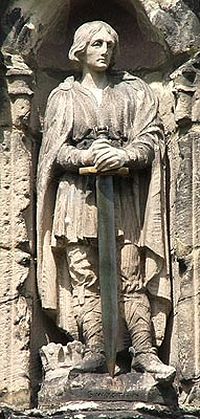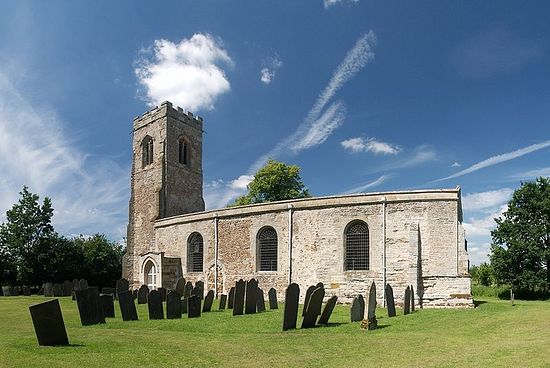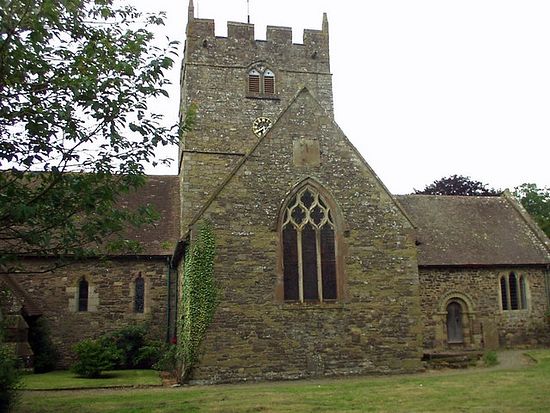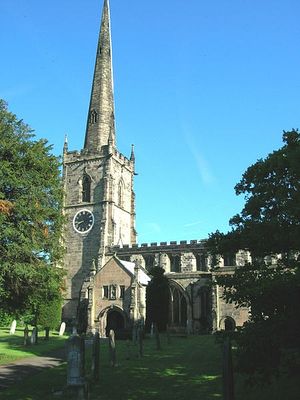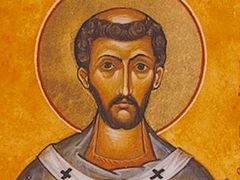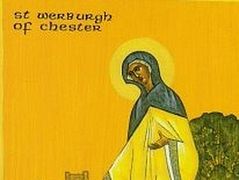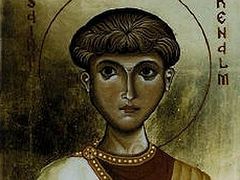There are a number of early English saints, mostly kings and princes, who have been venerated from time immemorial as what we call passion-bearers. These saints in most cases were slain not explicitly for Christ, but rather for the truth and righteousness. They were usually murdered by their coreligionist-Christians because of the latter’s spite, perfidy and involvement in plots, especially wishing to seize power. The saints in these cases are characterized by their meek non-resistance to their murderers. One such saint is St. Wistan (also Wigstan and Winston).
The future passion-bearer was born in the ninth century in Mercia, which was the largest early English kingdom. At its height Mercia stretched from the River Humber in the north to the Thames in the south, bordering the Celtic regions of Wales in the west and the Kingdom of the East Angles in the east. His birthplace may have been at or near Worcester. Wistan’s mother was called Aelflaed and she was the daughter of Ceolwulf I of Mercia. From his childhood, pious Wistan decided to devote all his life to the service of God in prayer and seclusion. It is known that he led a holy life though it is not known for certain if he was ever tonsured a monk. King Wiglaf of Mercia, the saint’s grandfather, ruled Mercia from 827 till 839. Wiglaf’s son and St. Wistan’s father called Wigmund died shortly before him, and so after Wiglaf’s death Wistan was proclaimed king.
According to one version, St. Wistan, then still very young, briefly ruled in 840, then abdicated for the ascetic life, and, according to another and more popular version, he abdicated at once in favor of King Beorhtwulf (840-852). However, Wistan temporarily appointed his mother Aelflaed as a regent. Wistan’s godfather named Beorhtric (Brifardus), son of Beorhtwulf, was chosen as his mother’s adviser. Seized by a thirst for power, Beorhtric soon wished to marry Aelflaed despite their spiritual kinship. Devout Wistan reminded him that such a marriage would contradict the canons. Perhaps for this or another political reason the perfidious Beorhtric cruelly beheaded the humble and God-fearing Wistan, while he was standing in prayer. The martyrdom took place on June 1, 850 (some sources also give 840 and 849). The site of the holy prince’s martyrdom was therefore called “Wistanstowe,” that is, “the holy place of St. Wistan.” Most hagiographers identify this spot with the village of Wistow in the county of Leicestershire, though an alternative (and less probable) candidate is Wistanstow in the county of Shropshire.
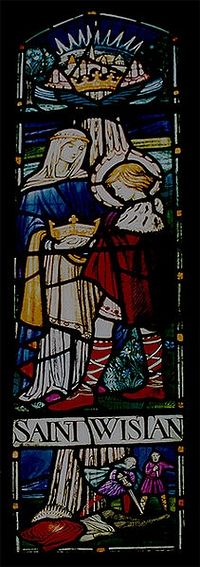 St. Wistan's stained glass window at Wistanstow church by the artist Margaret Edith Rope (photo by Zorga the Geek)
St. Wistan's stained glass window at Wistanstow church by the artist Margaret Edith Rope (photo by Zorga the Geek) About the year 1020 the Danish King Canute of England (1017-1030) ordered the relics to be translated to the great and important Evesham Monastery in Worcestershire, where they were kept until the Reformation, and visited (along with the relics of other saints that were kept there) by thousands of pilgrims. After the Norman Conquest, in the year 1077, the Norman Abbot Walter of Evesham decided to subject the relics of local saints to “ordeal by fire,” as the Normans often doubted the sainthood of many pre-schism local saints of Britain. So, according to tradition, when it was the turn of St. Wistan’s relics, the fire even did not touch them, but the holy body itself changed color and began to shine! Filled with fear and awe, Walter took the body and head of the holy martyr and was about to put them back in the shrine, but the saint’s head suddenly fell on the ground and started to give out a fluid, while a sweet smell of fragrance spread around the church. The faithful who were present praised God in reverence, and Walter was ashamed for his unholy deed and venerated local saints henceforth. Evesham Monastery was dissolved and destroyed in the sixteenth-century Reformation and the relics of all its saints disappeared.
But the veneration of the glorious passion-bearer Wistan in England still lives today. He is venerated in Derbyshire, Leicestershire, Worcestershire and Shropshire. Apart from Wistow in Leicestershire there are other villages with the same name, in the counties of Cambridgeshire and North Yorkshire, in honor of St. Wistan. An example of a celebrity who bore the name of this saint is the famous and influential British-born poet Wistan Hugh (W.H.) Auden (1907-1973) who later moved to the USA.
The tiny hamlet of Wistow lies some five miles south of the city of Leicester in a picturesque area of central England in the valley of the River Sence. The village church is dedicated to St. Wistan—it was here that the young prince was slain in the ninth century. The first Saxon church was rebuilt by the Normans and the present building is mostly Norman with a thirteenth-century tower. The church is beautiful yet simply decorated both outside and inside. It was restored in the Georgian era. There used to be a holy well near the church that had curative properties.
The memory of St. Wistan has lived on in the town of Wigston Magna near Leicester for over 1,000 years in spite of the Reformation. According to tradition, after the saint’s death his holy body was translated from Wistow to Repton, but during the journey the procession stopped overnight in what is now Wigston Magna: suddenly healing miracles began to occur on that spot and a chapel in honor of the saint was erected there. The relics were moved to Repton, but the chapel dedicated to St. Wistan continued to exist in Wigston, attracting many pilgrims. In this chapel there stood a specially venerated statue of St. Wistan, adorned with jewels, which was noted for its healing powers. In the Middle Ages the town of Wigston was commonly known as “Wigston Two Steeples” on the account of the very high spires of its two churches—All Saints’ Church and St. Wistan’s Chapel. During the Reformation the saint’s figure was probably destroyed and the chapel closed. From that time on it was used for various secular purposes and eventually nearly fell into ruin. In 1877 the chapel was re-consecrated and services in it resumed, and in 1957 it was again dedicated to St. Wistan. Now it is used as a parish church and pilgrimages go on.
The small village of Wistanstow is located not far from the town of Craven Arms in Shropshire in western England. This village is named after St. Wistan, who is commemorated here in a stained glass inside the local twelfth-thirteenth-century Holy Trinity parish Church—the author is the famous stained glass artist Margaret Edith Rope (1891-1988).
The parish church of Repton in Derbyshire, close to the River Trent in central England, is still dedicated to St. Wistan. Its tall spire is some 212 feet, or 65 meters, high. It was here that the martyr’s holy relics lay from c.850 until c.1020, visited by thousands of pilgrims every year. Early in the eighth century a crypt was built and enlarged under this church to be used first as a baptistery (it was fed by a holy well), and soon afterwards as a mausoleum and the burial-place of the Mercian kings. Thus, the father and grandfather of St. Wistan, mentioned above, were buried there, along with King Aethelbald of Mercia (ruled 716-757, a spiritual son of St. Guthlac of Crowland) and, finally, St. Wistan. The influx of pilgrims to the shrine of St. Wistan was so intense that two separate passages from the upper church to the crypt were built. This Saxon crypt is over 1200 years old still survives practically intact, making Repton church one of the most complete Anglo-Saxon architectural gems in England still in existence1. The English poet and expert on architecture, Sir John Betjeman (1906-1984), referred to this crypt as “the holy air encased in stone”. The church was finely rebuilt in the fourteenth century but there is some good Saxon stonework remaining even outside the crypt, namely in the chancel walls and in the north transept. Pilgrimages to this holy site continue. Although the main relics of St. Wistan were translated from Repton to Evesham in c.1020, a small relic of this saint was returned here in the thirteenth century. Repton was considered to be one of very important monastic sites in central England (and former Mercia) for nearly 1,000 years. The first (and double) monastery was built here in 656,2 when Peada, the first Mercian king to become a Christian, was baptized by St. Finan of Lindisfarne. Peada, a son of the ferocious pagan Penda of Mercia, gladly embraced the faith of Christ but unfortunately was slain on Easter, 656, betrayed by his treacherous wife, after ruling over south Mercia for about a year. For a short time Repton was the center of Mercian Christianity, though in the 660s the bishop’s see of the kingdom was established in Lichfield.
Repton is closely connected with many saints. The saintly, Irish-born missionary Diuma, who was sent from Northumbria to preach the Gospel in Mercia, well may have preached here. Later, in 697-699, the greatest English hermit, St. Guthlac of Crowland, was tonsured and trained in Repton, before moving to the Fens. Late in the seventh century the Holy Abbess Werburgh of Mercia briefly ruled over this monastery, succeeded by St. Edburga who is mentioned in the Life of St. Guthlac. Though, of course, the most beloved saint of Repton is Wistan, to whom this splendid church is still dedicated. A statue of St. Wistan holding a sword can be seen above the porch door of the church. Inside the church Sts. Wistan, Guthlac, Diuma and Chad (the Apostle of Mercia) are commemorated in stained glass windows in the south transept. The church has many other monuments and decorations inside.
The Orthodox monastery at Repton ceased to exist in 873, when the heathen Great Danish Army occupied this site and encamped there (recently mass Danish burials and other related artefacts were discovered near Repton church). The monks of Repton managed to flee with St. Wistan’s relics to a secure site, and when the Danes left, the relics were returned and the church restored, though the monks did not come back. After the Norman Conquest an Augustinian Priory of the Holy Trinity appeared in Repton near the present church in about 1150, founded by Matilda, countess of Chester, while St. Wistan’s Church was used only as a parish church. The priory existed until the Reformation, and now only some of its ruins survive. Some of the buildings of the former priory have for many years been used by Repton School. An atmosphere of sanctity reigns in this ancient holy site to this day, especially in the church and its crypt.
Holy Passion-Bearer Wistan, pray to God for us!

